How would you react if one day your entire world was throw upside down? Would you pull yourself together and face this daunting new task, or would you run and hide and pray for it all to end? Would you be strong enough to protect your fiends, or would you be selfish and think only of yourself. Would you have the willpower to see your journey through to the very end, as scary and dismal as it might be, or would you just give up and fade into anonymity as the world around you descended into madness and anarchy?

These are the questions put forth in the manga “Magic Knights Rayearth,” one of the earlier works by development team CLAMP. While they might be better known for series like “Chobits,” “Cardcaptor Sakura” and the pivotal “X,” Rayearth is a lovely little title (and I do mean little: it’s only 3 volumes) that came and went in the late 1990s with little real fanfare, but which built up a rather sizable following here in the United States, mostly courtesy of Tokyopop.

Rayearth holds a special place in my heart, because it was one of the first manga I ever read. While nowadays getting manga is as easy as walking into a bookstore, library, or browsing the internet, way back in the late 90s, it was still a very limited, very niche market. While we see Shonen Jump and Yen Press monthly digests with regularity, back then there was pretty much just one magazine, if you could find it: MiXXzine, put out by one Stu Levy, who would eventually introduce manga to hordes of fans and then close shop, leaving a lot of them hanging.
MiXX contained four stories. In addition to Rayearth, there was an early translation of “Sailor Moon” (in which she was named “Bunny,” more accurate than Serena, but also not very serious for a hero), “Parasyte,” which was a violent, gritty story of alien invasions that I also still read and “Iceblade,” a story about an emotionless cop, which I haven’t seen since MiXX vanished. But of the four titles, it was Rayearth that I enjoyed the most, since it was a “MiXX” (hawhaw) of themes that I liked, right down to the JRPG feel of the quest, which appealed to the Final Fantasy/D&D dork inside. (The cute girls didn’t hurt either: I admit to having a huge crush on Hikaru. I was 16. Sue me.)
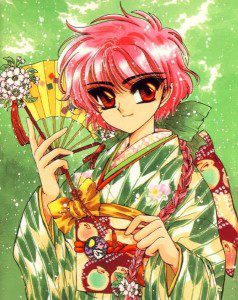
So when I found a copy of the Omnibus for sale at this year’s Anime Mid-Atlantic, I had to get it, if only to take a brief trip down memory lane. (Also, I needed to finish the story. MiXX only published 1-2 chapters at a time, and I never got past the first volume of the story by the time the magazine vanished from my local stationery store.)
The story behind Rayearth is rather typical of a girl’s adventure manga. Three middle school students, Hikaru, Umi and Fuu, are pulled from the real world into the magical land of Cephiro by the Princess Emeraude, and tasked with rescuing her from her captor, the priest Zagato. You see, in Cephiro, everything is controlled by willpower, and it was the will of the Princess that kept it functioning orderly. But after her abduction, the world was thrown into disarray, with monsters appearing everywhere, and great heroes attempting to save her, with results almost uniformly in vain. Because the only ones who CAN save her are people summoned from another world- only then can they awaken the legendary gods of Cephiro, the Mashen, and stop the evil of Zagato.
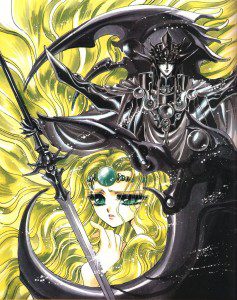
At least, that’s the story at the beginning. Over three volumes, the manga actually does begin to resemble a fantasy RPG (and for the record, one does exist, for the SNES, and you can find translated ROMs online for it. It’s short and mildly entertaining, moreso if you’re a fan of the source material), with the three main characters openly saying such. There are moments of “leveling up,” plenty of monsters to encounter and fight, and clearly defined “dungeons” and “bosses” to overcome. As the tale unfolds, the three girls must confront new allies, new enemies, and ultimately themselves if they wish to proceed, moving all the way to the battle with Zagato at story’s end. And, in case you’re wondering, there is a twist hidden in there as well, and the ending is somewhat unforseen. Vintage CLAMP, if you ask me, and very welcome.
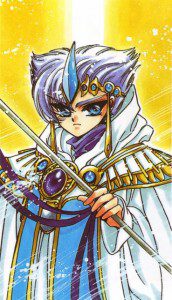
The real issue at heart when looking at this series is pacing. Though I never noticed it when I was reading it digest-style, it moves too fast at times in omnibus form, and the story seems very rushed. Interesting allies appear only once, leave indelible marks on the main characters, and then vanish, only to be mentioned causally again later in the story, if at all. (Seriously, why make Guru Clef seem so uber-awesome, then forget he existed?) Progression from normal girls into Magic Knights also seemed to move too quickly, almost like the story was taking place in a single afternoon, rather than across days (though judging time in Cephiro is extremely difficult as well). While this is fine for something plainly geared at teenage girls, it inevitably leaves the manga feeling a bit forced at times, not quite inaccessible to adults, but also lacking that special something. Given the subject matter and the interesting nature of both Cephiro as a world governed by willpower, and the girls as outsiders forced to survive there, I felt that not enough time was given to exploration and discovery, and everything they needed to progress was plainly there when they needed it. The story was so linear, it almost handicapped it from reaching its full potential, and potential did it have!
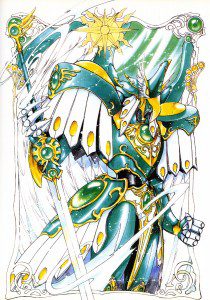 However, Rayearth is not a bad manga by any stretch. While not as developed or possessing the same impact as later titles like “X” or “xXxholic,” it still offers a glimpse into how CLAMP progressed from doujinshi artists into the team they are today. Each of the girls serves as a blueprint for the protagonists in many of their future series (Hikaru and “Cardcaptor” Sakura are inherently the same at times), and it is easy to see where CLAMP started to build their roots as mangaka and storytellers.
However, Rayearth is not a bad manga by any stretch. While not as developed or possessing the same impact as later titles like “X” or “xXxholic,” it still offers a glimpse into how CLAMP progressed from doujinshi artists into the team they are today. Each of the girls serves as a blueprint for the protagonists in many of their future series (Hikaru and “Cardcaptor” Sakura are inherently the same at times), and it is easy to see where CLAMP started to build their roots as mangaka and storytellers.
While this series has been out of print for a while now, it’s well worth the time to track it down and give it a read. While not perfect, it is at its core entertaining and lighthearted, and a lovely diversion for a summer afternoon. There have also been two anime series devoted to the material, both of which allow for more time exploring the characters and the expanded story of Cephiro than the original manga did
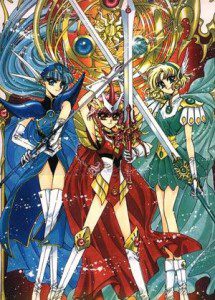
[tube]jKlFlBXR_7c[/tube]


MKR is a personal favorite anime of mine, perhaps my second favorite anime TV series after Ranma 1/2.
By any chance, have you played the Saturn MKR game?
I didnt even know there was a Saturn version. I played the SNES one a few times, usually for nostalgia’s sake.
I need to get that omnibus. It’s been on my wishlist for a while.